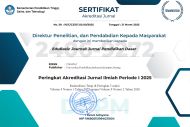Animated Video Development in Thematic Learning in the Fifth Grade of Elementary School
Abstract
Thematic learning for elementary students is challenging since combining many subjects matter in one topic so the appropriate medium to deliver the subject should be taken into consideration. This study aims to develop animated videos in fifth grade at SDN Cijeruk and determine the video’s feasibility and student responses after using the video. The background of this research is that the teacher only used the lecture method and textbooks, making students feel bored and sleepy. In addition, teachers did not make good use of school facilities with laptops, InFocus, and speakers to apply digital learning media. Teachers also did not make use of their soft skills in using technology. This research method was R&D (Research and Development) using the ADDIE model, consisting of five stages: analysis, design, development, implementation, and evaluation. The results of the material expert validation from the two validators obtained an average percentage of 89.5%, on the criteria of "very feasible." The validation of linguists from the two validators attained an average percentage of 87% on the "very feasible" criterion. Furthermore, the average percentage of media expert validation from the two validators was 88.5% in the "very feasible" criteria. Hence, the overall average percentage of the material, language, and media validators was 88.3% in the "very feasible" criteria. For student responses, an average percentage of 97.475% was also obtained in the "very good" criteria. Based on the validation results and student responses, this animated video is feasible for school use.
Keywords
Full Text:
PDFReferences
Agustien, R., Umamah, N., & Sumarno, S. (2018). Pengembangan media pembelajaran video animasi dua dimensi Situs Pekauman di Bondowoso dengan model Addie mata pelajaran sejarah kelas X IPS. Jurnal Edukasi, 5(1), 19–23.
Akmalia, R., Fajriana, F., Rohantizani, R., Nufus, H., & Wulandari, W. (2021). Development of Powtoon animation learning media in improving understanding of mathematical concept. Malikussaleh Journal of Mathematics Learning (MJML), 4(2), 105–116.
Ananda, R. (2017). Penggunaan media audio visual untuk meningkatkan hasil belajar pendidikan kewarganegaraan siswa kelas IV SD Negeri 016 Bangkinang Kota. Jurnal Basicedu, 1(1), 21–30.
Apriansyah, M. R. (2020). Development of learning media animated building materials science course in the undergraduate course of engineering education building State University of Jakarta. Jurnal Pensil: Pendidikan Teknik Sipil, 9(1), 9–18.
Adlan, A., Alfath, I. A., & Setiabudi, D. I. (2022). Analisis pendekatan saintifik pada buku tematik siswa kelas II SD Kurikulum 2013 Tema 3. Jurnal Pendidikan dan Sastra Inggris, 2(2), 12–19.
Hikmah, V. N., & Purnamasari, I. (2017). Pengembangan video animasi “Bang Dasi” berbasis aplikasi camtasia pada materi bangun datar kelas V sekolah dasar. Mimbar Sekolah Dasar, 4(2), 182–191.
Jamun, M. Y. (2018). Dampak teknologi terhadap pendidikan. Jurnal Pendidikan dan Kebudayaan Missio, 10(1), 48–52.
Johari, A., Hasan, S., & Rakhman, M. (2014). Penerapan media video dan animasi pada materi memvakum dan mengisi refrigeran terhadap hasil belajar siswa. Journal of Mechanical Engineering Education, 1(1), 8–15.
Kirom, A. (2017). Peran guru dan peserta didik dalam proses pembelajaran berbasis multikultural. Al-Murabbi: Jurnal Pendidikan Agama Islam, 3(1), 69–80.
Mashuri, D. K., & Budiyono, B. (2020). Pengembangan media pembelajaran video animasi materi volume bangun ruang untuk SD kelas V. Jurnal Penelitian Pendidikan Guru Sekolah Dasar, 8(5), 893–903.
Ngenda, F. V., & Ajizah, A., & Amintarti, S. (2021). Pengembangan media pembelajaran berbasis video animasi powtoon pada konsep tumbuhan lumut dan paku-pakuan kelas X SMA. QUANTUM: Jurnal Inovasi Pendidikan Sains, 12(2), 136–148.
Nurfa, N., Aripin, A., & Susanti, E. (2022). Pengembangan media pembelajaran learning management system berbasis moodle sebagai daya dukung pembelajaran fisika. Jurnal Eksakta Pendidikan (JEP), 6(2), 143–151.
Oktafiani, D., Nulhakim, L., & Alamsyah, T. P. (2020). Pengembangan media pembelajaran IPA berbasis multimedia interaktif menggunakan Adobe Flash pada kelas IV. Jurnal Mimbar PGSD Undiksha, 8(3), 527–540.
Pane, A., & Dasopang, M. D. (2017). Belajar dan pembelajaran. Jurnal Kajian Ilmu-Ilmu Keislaman, 3(2), 333–352.
Ponza, P. J. R., Jampel, N., & Sudarma, K. (2018). Pengembangan media video animasi pada pembelajaran siswa kelas IV di sekolah dasar. Jurnal EDUTECH Undiksha, 6(1), 9–19.
Rahmawati, F., & Atmojo, I. R. W. (2021). Analisis media digital video pembelajaran abad 21 menggunakan aplikasi canva pada pembelajaran IPA. Jurnal Basicedu, 5(6), 6271–6279.
Rohayati, T., & Rizkyanti, A. S. (2019). The use of snakes and ladders games in teaching vocabulary project. PROJECT (Professional Journal of English Education), 2(6), 797–805.
Sakti, I., & Napsawati, N. (2021). The development of learning media using Powtoon for junior high school. Jurnal Pendidikan Fisika, 9(3), 198–208.
Sunami, M. A., & Aslam, A. (2021). Pengaruh penggunaan media pembelajaran video animasi berbasis zoom meeting terhadap minat dan hasil belajar IPA siswa sekolah dasar. Jurnal Basicedu, 5(4), 1940–1945.
Sylvia, I., Anwar, S., & Khairani, K. (2019). Pengembangan instrumen penilaian autentik berbasis pendekatan authentic inquiry learning pada mata pelajaran sosiologi di sekolah menengah atas. Jurnal Socius: Journal of Sociology Research and Education, 6(2), 103–120.
Widiyasanti, M., & Ayriza, Y. (2018). Pengembangan media video animasi untuk meningkatkan motivasi belajar dan karakter tanggung jawab siswa kelas V. Jurnal Pendidikan Karakter, 9(1), 1–16.
Zahra, F. A., Sekaringtyas, T., & Hasanah, U. (2021). Pengembangan poster interaktif berbasis android pada muatan IPA kelas IV sekolah dasar. OPTIKA: Jurnal Pendidikan Fisika, 5(2), 131–144.
DOI: https://doi.org/10.17509/ebj.v5i1.51650
Refbacks
- There are currently no refbacks.
Copyright (c) 2023 Universitas Pendidikan Indonesia
This work is licensed under a Creative Commons Attribution 4.0 International License.
This journal is indexed by




.png)




.png)
1.png)


1.png)

.png)